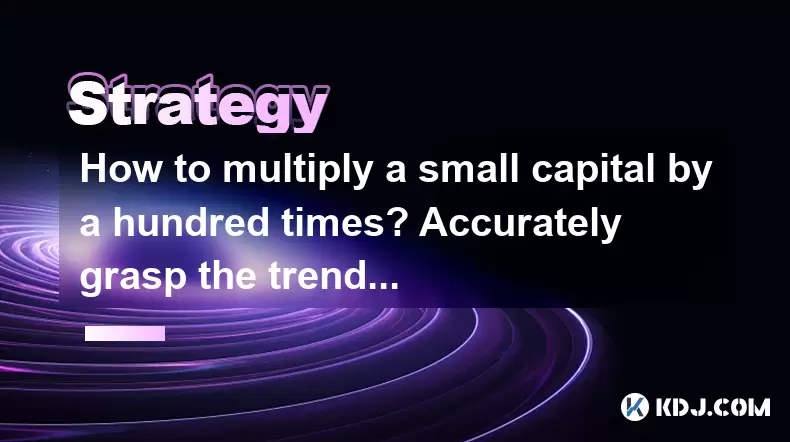-
 bitcoin
bitcoin $87959.907984 USD
1.34% -
 ethereum
ethereum $2920.497338 USD
3.04% -
 tether
tether $0.999775 USD
0.00% -
 xrp
xrp $2.237324 USD
8.12% -
 bnb
bnb $860.243768 USD
0.90% -
 solana
solana $138.089498 USD
5.43% -
 usd-coin
usd-coin $0.999807 USD
0.01% -
 tron
tron $0.272801 USD
-1.53% -
 dogecoin
dogecoin $0.150904 USD
2.96% -
 cardano
cardano $0.421635 USD
1.97% -
 hyperliquid
hyperliquid $32.152445 USD
2.23% -
 bitcoin-cash
bitcoin-cash $533.301069 USD
-1.94% -
 chainlink
chainlink $12.953417 USD
2.68% -
 unus-sed-leo
unus-sed-leo $9.535951 USD
0.73% -
 zcash
zcash $521.483386 USD
-2.87%
How to multiply a small capital by a hundred times? Accurately grasp the trend trading in the cryptocurrency circle!
To multiply capital by 100x in crypto, master trend trading: identify trends early, use tools like moving averages and RSI, and manage risk with stop-losses and take-profits.
Jun 05, 2025 at 07:15 am

In the world of cryptocurrencies, the potential for massive gains is both alluring and real. Multiplying a small capital by a hundred times is a dream many investors chase, but it requires a deep understanding of trend trading and the ability to execute it effectively. This article will guide you through the process of trend trading in the cryptocurrency circle, providing detailed insights and practical steps to help you achieve significant returns.
Understanding Trend Trading in Cryptocurrencies
Trend trading involves identifying and following the direction of the market's momentum. In the cryptocurrency market, trends can be short-lived or last for extended periods, influenced by factors such as market sentiment, news events, and technological developments. The key to successful trend trading is to accurately identify these trends early and ride them until they show signs of reversal.
To start, you need to understand the basic types of trends: uptrends, downtrends, and sideways trends. An uptrend is characterized by higher highs and higher lows, indicating a bullish market. A downtrend features lower highs and lower lows, signaling a bearish market. Sideways trends, or ranges, occur when the price moves within a relatively stable band, indicating a lack of clear direction.
Tools and Indicators for Identifying Trends
Several tools and indicators can help you identify trends in the cryptocurrency market. Moving averages are one of the most popular and effective tools for trend identification. A simple moving average (SMA) smooths out price data over a specified period, making it easier to spot the direction of the trend. A common strategy is to use two moving averages with different time frames, such as a 50-day and a 200-day SMA. When the shorter-term moving average crosses above the longer-term one, it's often seen as a bullish signal, and vice versa for a bearish signal.
Another useful indicator is the Relative Strength Index (RSI). The RSI measures the speed and change of price movements, helping you determine if a cryptocurrency is overbought or oversold. An RSI above 70 suggests that the asset may be overbought and due for a correction, while an RSI below 30 indicates it may be oversold and poised for a rebound.
Setting Up Your Trading Strategy
Once you have identified a trend using the tools mentioned above, the next step is to set up your trading strategy. Here are some key elements to consider:
- Entry Points: Look for opportunities to enter the market when the trend is confirmed. For an uptrend, you might enter when the price breaks above a resistance level or when the shorter-term moving average crosses above the longer-term one.
- Stop-Loss Orders: Always use stop-loss orders to protect your capital. Set your stop-loss just below a recent low in an uptrend or above a recent high in a downtrend. This helps limit your losses if the market moves against you.
- Take-Profit Levels: Determine your take-profit levels based on key resistance or support levels. In an uptrend, you might set your take-profit at a previous high or a significant resistance level.
Executing Trades and Managing Risk
Executing trades in the cryptocurrency market requires precision and discipline. Here are some steps to follow:
- Choose a Reliable Exchange: Select a reputable cryptocurrency exchange that offers the assets you want to trade and provides robust security measures.
- Fund Your Account: Deposit your capital into your exchange account, ensuring you only invest what you can afford to lose.
- Place Your Orders: Use the exchange's trading platform to place your buy and sell orders according to your strategy. Make sure to set your stop-loss and take-profit levels as planned.
- Monitor Your Trades: Keep an eye on your trades and be ready to adjust your stop-loss and take-profit levels as the market evolves. Remember, the cryptocurrency market can be highly volatile, so staying vigilant is crucial.
Case Studies: Successful Trend Trading in Cryptocurrencies
To illustrate how trend trading can lead to significant gains, let's look at a couple of case studies:
- Bitcoin in 2017: Bitcoin experienced a massive uptrend throughout 2017, with its price soaring from around $1,000 at the beginning of the year to nearly $20,000 by December. Traders who identified this trend early and held onto their positions could have multiplied their capital by a hundred times or more.
- Ethereum in 2020-2021: Ethereum saw a significant uptrend from late 2020 to early 2021, with its price rising from around $300 to over $4,000. Traders who entered the market during the early stages of this trend and managed their positions effectively could have achieved substantial returns.
Frequently Asked Questions
Q: Can trend trading be applied to all cryptocurrencies?A: Trend trading can be applied to most cryptocurrencies, but it's most effective with assets that have sufficient liquidity and trading volume. Less liquid cryptocurrencies may exhibit more erratic price movements, making trend identification and trading more challenging.
Q: How much capital do I need to start trend trading in the cryptocurrency market?A: The amount of capital needed depends on your risk tolerance and trading strategy. However, starting with a small capital is possible, as long as you manage your risk effectively and use proper position sizing.
Q: Is trend trading suitable for beginners?A: Trend trading can be suitable for beginners, but it requires a solid understanding of the market and the ability to manage risk. Beginners should start with a demo account or small trades to gain experience before risking significant capital.
Q: How often should I monitor my trend trading positions?A: The frequency of monitoring depends on the volatility of the cryptocurrency you're trading and the duration of your trades. For highly volatile assets, daily monitoring is advisable, while less volatile assets might require less frequent checks. Always be prepared to adjust your strategy based on market conditions.
Disclaimer:info@kdj.com
The information provided is not trading advice. kdj.com does not assume any responsibility for any investments made based on the information provided in this article. Cryptocurrencies are highly volatile and it is highly recommended that you invest with caution after thorough research!
If you believe that the content used on this website infringes your copyright, please contact us immediately (info@kdj.com) and we will delete it promptly.
- Crypto, FLOKI, Apeing: Navigating the Meme Coin Frenzy Like a Wall Street Wolf
- 2025-11-26 10:45:02
- Aptos' Price Performance Struggles: Is There Hope for a Rebound?
- 2025-11-26 09:15:01
- Chainlink (LINK) Open Interest: Bulls Eye $15 Amid ETF Buzz!
- 2025-11-26 10:15:01
- PEPE, ZCash, and Zero Knowledge: A Tale of Three Cryptos
- 2025-11-26 06:45:01
- Abigail D'Morais: A Challenge Coin, Work-Based Learning Star
- 2025-11-26 07:20:02
- Pepe Price Prediction: Traders Watching Closely as PEPENODE Steals the Show
- 2025-11-26 05:50:02
Related knowledge

How to Bridge Your Crypto Assets: A Beginner's Guide to Cross-Chain Swaps.
Nov 21,2025 at 06:39pm
Understanding Cross-Chain Bridges in the Crypto Ecosystem1. Cross-chain bridges are protocols that allow users to transfer digital assets from one blo...

How to Backtest a Crypto Trading Strategy: A Guide to Data-Driven Decisions.
Nov 20,2025 at 12:40pm
Data Collection for Accurate Backtesting1. Historical price data forms the backbone of any crypto backtesting process. Reliable sources such as Binanc...

A Guide to Trading Altcoin Seasons: How to Maximize Your Gains.
Nov 16,2025 at 11:00pm
Understanding Altcoin Seasons1. An altcoin season refers to a market phase where alternative cryptocurrencies outperform Bitcoin in terms of price gro...

How to Lend Your Crypto: A Simple Guide to Earning Interest.
Nov 18,2025 at 01:19am
Lending Crypto: Understanding the Basics1. Cryptocurrency lending allows users to earn interest by providing their digital assets to borrowers through...

The Beginner's Guide to Decentralized Exchanges (DEX): Trading with Control.
Nov 16,2025 at 05:20pm
The Beginner's Guide to Decentralized Exchanges (DEX): Trading with Control Decentralized exchanges, commonly known as DEXs, are transforming the way ...

How to Use Fibonacci Retracement in Crypto: A Guide for Technical Traders.
Nov 20,2025 at 01:39am
Understanding Fibonacci Retracement in the Context of Cryptocurrency Trading1. Fibonacci retracement is a popular technical analysis tool derived from...

How to Bridge Your Crypto Assets: A Beginner's Guide to Cross-Chain Swaps.
Nov 21,2025 at 06:39pm
Understanding Cross-Chain Bridges in the Crypto Ecosystem1. Cross-chain bridges are protocols that allow users to transfer digital assets from one blo...

How to Backtest a Crypto Trading Strategy: A Guide to Data-Driven Decisions.
Nov 20,2025 at 12:40pm
Data Collection for Accurate Backtesting1. Historical price data forms the backbone of any crypto backtesting process. Reliable sources such as Binanc...

A Guide to Trading Altcoin Seasons: How to Maximize Your Gains.
Nov 16,2025 at 11:00pm
Understanding Altcoin Seasons1. An altcoin season refers to a market phase where alternative cryptocurrencies outperform Bitcoin in terms of price gro...

How to Lend Your Crypto: A Simple Guide to Earning Interest.
Nov 18,2025 at 01:19am
Lending Crypto: Understanding the Basics1. Cryptocurrency lending allows users to earn interest by providing their digital assets to borrowers through...

The Beginner's Guide to Decentralized Exchanges (DEX): Trading with Control.
Nov 16,2025 at 05:20pm
The Beginner's Guide to Decentralized Exchanges (DEX): Trading with Control Decentralized exchanges, commonly known as DEXs, are transforming the way ...

How to Use Fibonacci Retracement in Crypto: A Guide for Technical Traders.
Nov 20,2025 at 01:39am
Understanding Fibonacci Retracement in the Context of Cryptocurrency Trading1. Fibonacci retracement is a popular technical analysis tool derived from...
See all articles










































































